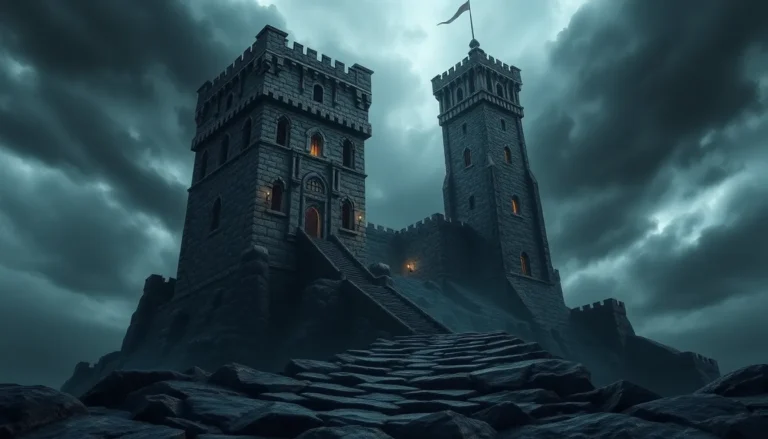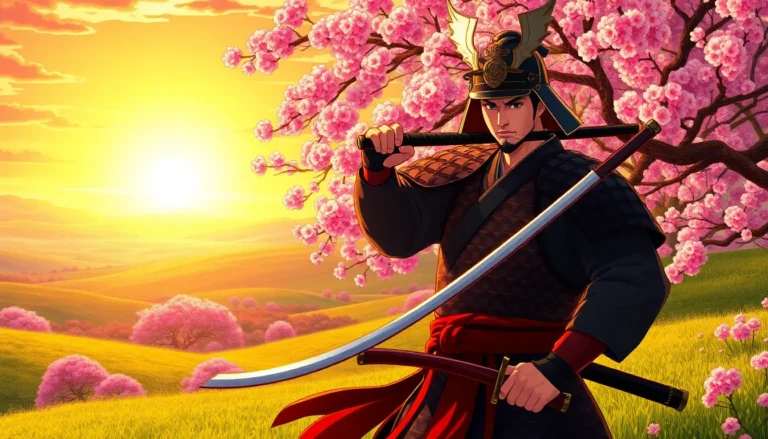Table of Contents
ToggleIn the breathtaking world of Ghost of Tsushima, every samurai knows that a warrior is only as good as their weapon. From the iconic katana to the stealthy bow, each tool tells a story of honor and vengeance. Whether you’re slicing through Mongol hordes or gracefully navigating the shadows, these weapons are more than just shiny objects—they’re extensions of the warrior’s spirit.
Overview of Ghost of Tsushima Weapons
Weapons in Ghost of Tsushima play a pivotal role in shaping the gameplay experience. The katana, known as the “Ghost’s weapon,” symbolizes honor and skill. Players wield it to engage in intense sword fights, showcasing both precision and fluidity. Each strike embodies the path of the samurai, emphasizing the importance of technique and respect.
Bows serve a different purpose, offering ranged combat options. Players use the bow for stealthy takedowns and reconnaissance. Arrows fly silently, allowing for tactical advantages during encounters. Additionally, various bow types enhance versatility in combat situations. The Longbow delivers power, while the Shortbow offers quick shots.
Moreover, other tools contribute to the overall strategy. Smoke bombs create opportunities for escape or stealthy attacks. The grapple hook allows access to ledges, enabling high ground advantage. Each weapon complements the player’s style and decisions throughout the game.
Customization options enhance the experience. Players can upgrade weapons using materials gathered during exploration. This crafting mechanic fosters connection to the game’s world. Upgrades improve damage, speed, and effectiveness, ensuring that players can adapt to evolving challenges.
In essence, weapons transform into extensions of identity within Ghost of Tsushima. Mastery of each weapon type unlocks unique abilities, reflecting the warrior’s journey. From samurai showdowns to stealthy assassinations, the choice of weapon impacts gameplay significantly. Emphasizing depth and strategic choice keeps players engaged as they navigate Tsushima’s beautiful but dangerous landscapes.
Types of Weapons
Weapons in Ghost of Tsushima offer a variety of combat styles that fit different strategies. Players engage with these tools as extensions of their character’s spirit.
Melee Weapons
Melee weapons include the katana, which signifies honor and skill. The katana allows swift cuts in close combat, rewarding precision. Additionally, the tanto serves as a secondary weapon, perfect for stealthy encounters and precise strikes. Players can also utilize various sword techniques to enhance their melee combat. Mastering these techniques boosts the player’s effectiveness in fights against multiple enemies. Each melee weapon carries its own upgrades, which allows personalization based on playstyle.
Ranged Weapons
Ranged weapons provide essential versatility in combat scenarios. The longbow features a powerful draw, enabling long-distance shots that can take down foes silently. An assortment of arrows enhances combat strategies, including explosive and fire arrows for different situations. The shortbow offers quicker shots for swift engagements, ideal for fast-paced combat. Players can also utilize a grappling hook to navigate terrain and set up strategic attacks. Upgrades and enhancements for ranged weapons make them vital tools for stealth and confrontation.
Weapon Progression and Upgrades
Weapon progression in Ghost of Tsushima involves crafting and skill enhancements that shape the player’s combat experience.
Crafting and Materials
Crafting weapons requires players to locate materials across Tsushima’s diverse landscapes. Players gather resources such as iron, bamboo, and leather to enhance their gear. Selecting the right materials is crucial, as they determine the weapon’s strength and effectiveness. Dismantling unused or inferior weapons also provides valuable resources. Upgrading the katana unlocks additional damage and enhances combat abilities. Every material collected contributes to the warrior’s growth, intertwining exploration with weapon mastery.
Skill Trees
Skill trees offer a structured approach to character development and combat proficiency. Players can invest points in various categories tailored to their combat style. Unlocking skills improves attack techniques, stealth maneuvers, and defensive capabilities. Mastering the Way of the Ghost or the Samurai reveals unique abilities, such as increased damage or enhanced stealth. Prioritization in skill selection significantly impacts gameplay, allowing for tailored strategies in battles. Each choice shapes the character’s evolution, reinforcing the connection between skill and style.
Combat Strategies with Weapons
Combat in Ghost of Tsushima varies based on weapon choices, enhancing player strategy. Mastering different approaches leads to unique gameplay experiences.
Stealth Tactics
Stealth tactics rely on precision and timing. Players can use the bow for silent kills, eliminating enemies without raising alarms. Smoke bombs offer a strategic getaway or distraction, allowing for stealthy repositioning. The tanto serves as a close-quarters weapon, perfect for silent takedowns. Choosing the right moment to strike is crucial; engaging from the shadows keeps players one step ahead of enemies. Using the grappling hook enables quick escapes or vantage points for ambushing unaware foes. Overall, efficient stealth tactics cultivate a sense of freedom while navigating Tsushima.
Open Combat Techniques
Open combat techniques emphasize aggressiveness and skill. Engaging in direct battles often involves using the katana, showcasing fluid movements and powerful strikes. Different stances counter specific enemy types, allowing players to adapt quickly on the battlefield. Parrying attacks creates openings for counterattacks, rewarding precise timing. Utilizing the longbow allows for strategic distance while targeting foes, bringing versatility to combat scenarios. In heated encounters, players can assess surroundings and use environmental elements to gain an advantage. Mastering these techniques significantly enhances combat effectiveness.
Conclusion
The weapons in Ghost of Tsushima are more than just tools for combat. They represent the essence of the samurai’s journey through honor and vengeance. Each weapon choice influences gameplay and strategy, allowing players to tailor their approach to each encounter.
With the katana embodying skill and precision and the bow offering versatility in ranged combat, players can explore unique tactics that enhance their experience. The ability to upgrade and customize weapons deepens the connection to Tsushima’s world, making each victory feel earned.
Ultimately, mastering these weapons and their associated skills transforms the player’s journey into a rich narrative of personal growth and strategic depth. In the land of Tsushima, every swing of the sword and release of the bowstring tells a story of resilience and honor.







